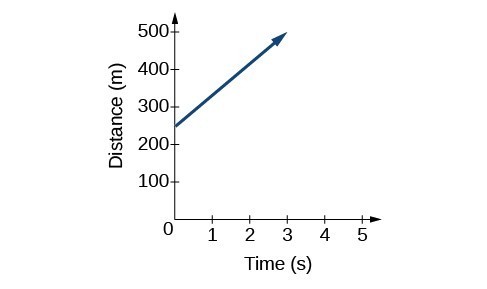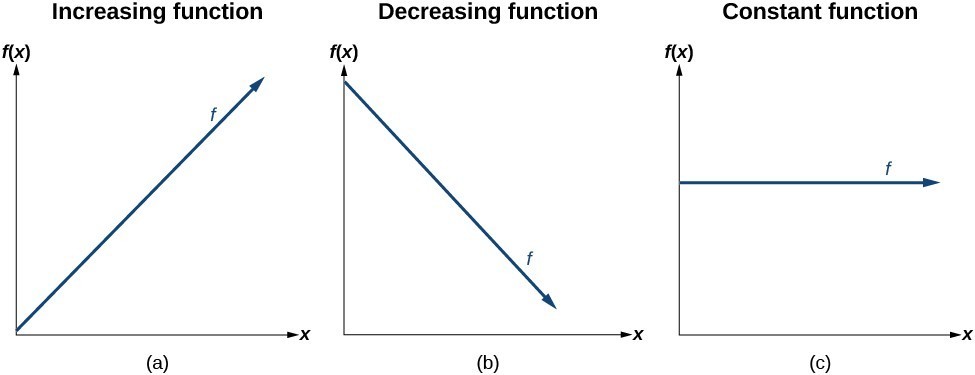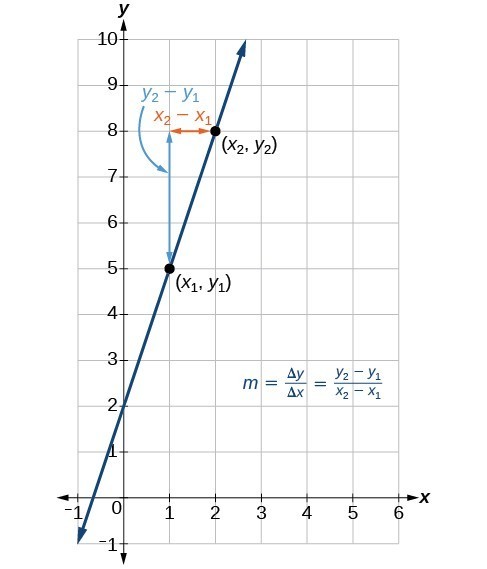Linear Functions
Imagine placing a plant in the ground one day and finding that it has doubled its height just a few days later. Although it may seem incredible, this can happen with certain types of bamboo species. These members of the grass family are the fastest-growing plants in the world. One species of bamboo has been observed to grow nearly 1.5 inches every hour.[footnote]http://www.guinnessworldrecords.com/records-3000/fastest-growing-plant/[/footnote] In a twenty-four hour period, this bamboo plant grows about 36 inches, or an incredible 3 feet! A constant rate of change, such as the growth cycle of this bamboo plant, is a linear function. A bamboo forest in China (credit: "JFXie"/Flickr)
A bamboo forest in China (credit: "JFXie"/Flickr)Characteristics of Linear Functions
Just as with the growth of a bamboo plant, there are many situations that involve constant change over time. Consider, for example, the first commercial maglev train in the world, the Shanghai MagLev Train. It carries passengers comfortably for a 30-kilometer trip from the airport to the subway station in only eight minutes.[footnote]http://www.chinahighlights.com/shanghai/transportation/maglev-train.htm[/footnote] Suppose a maglev train were to travel a long distance, and that the train maintains a constant speed of 83 meters per second for a period of time once it is 250 meters from the station. How can we analyze the train’s distance from the station as a function of time? In this section, we will investigate a kind of function that is useful for this purpose, and use it to investigate real-world situations such as the train’s distance from the station at a given point in time.
The function describing the train’s motion is a linear function, which is defined as a function with a constant rate of change, that is, a polynomial of degree 1. There are several ways to represent a linear function, including word form, function notation, tabular form, and graphical form. We will describe the train’s motion as a function using each method.
Suppose a maglev train were to travel a long distance, and that the train maintains a constant speed of 83 meters per second for a period of time once it is 250 meters from the station. How can we analyze the train’s distance from the station as a function of time? In this section, we will investigate a kind of function that is useful for this purpose, and use it to investigate real-world situations such as the train’s distance from the station at a given point in time.
The function describing the train’s motion is a linear function, which is defined as a function with a constant rate of change, that is, a polynomial of degree 1. There are several ways to represent a linear function, including word form, function notation, tabular form, and graphical form. We will describe the train’s motion as a function using each method.
Representing a Linear Function in Word Form
Let’s begin by describing the linear function in words. For the train problem we just considered, the following word sentence may be used to describe the function relationship.- The train’s distance from the station is a function of the time during which the train moves at a constant speed plus its original distance from the station when it began moving at constant speed.
Representing a Linear Function in Function Notation
Another approach to representing linear functions is by using function notation. One example of function notation is an equation written in the form known as the slope-intercept form of a line, where [latex]x[/latex] is the input value, [latex]m[/latex] is the rate of change, and [latex]b[/latex] is the initial value of the dependent variable.[latex]\begin{array}{l}\text{Equation form}\hfill & y=mx+b\hfill \\ \text{Equation notation}\hfill & f\left(x\right)=mx+b\hfill \end{array}[/latex]
In the example of the train, we might use the notation [latex]D\left(t\right)[/latex] in which the total distance [latex]D[/latex] is a function of the time [latex]t[/latex]. The rate, [latex]m[/latex], is 83 meters per second. The initial value of the dependent variable [latex]b[/latex] is the original distance from the station, 250 meters. We can write a generalized equation to represent the motion of the train.[latex]D\left(t\right)=83t+250[/latex]
Representing a Linear Function in Tabular Form
A third method of representing a linear function is through the use of a table. The relationship between the distance from the station and the time is represented in the table below. From the table, we can see that the distance changes by 83 meters for every 1 second increase in time. Tabular representation of the function D showing selected input and output values
Tabular representation of the function D showing selected input and output valuesQ & A
Can the input in the previous example be any real number? No. The input represents time, so while nonnegative rational and irrational numbers are possible, negative real numbers are not possible for this example. The input consists of non-negative real numbers.Representing a Linear Function in Graphical Form
Another way to represent linear functions is visually, using a graph. We can use the function relationship from above, [latex]D\left(t\right)=83t+250[/latex], to draw a graph, represented in the graph below. Notice the graph is a line. When we plot a linear function, the graph is always a line. The rate of change, which is constant, determines the slant, or slope of the line. The point at which the input value is zero is the vertical intercept, or y-intercept, of the line. We can see from the graph that the y-intercept in the train example we just saw is [latex]\left(0,250\right)[/latex] and represents the distance of the train from the station when it began moving at a constant speed. The graph of [latex]D\left(t\right)=83t+250[/latex]. Graphs of linear functions are lines because the rate of change is constant.
The graph of [latex]D\left(t\right)=83t+250[/latex]. Graphs of linear functions are lines because the rate of change is constant.A General Note: Linear Function
A linear function is a function whose graph is a line. Linear functions can be written in the slope-intercept form of a line[latex]f\left(x\right)=mx+b[/latex]
where [latex]b[/latex] is the initial or starting value of the function (when input, [latex]x=0[/latex]), and [latex]m[/latex] is the constant rate of change, or slope of the function. The y-intercept is at [latex]\left(0,b\right)[/latex].Example: Using a Linear Function to Find the Pressure on a Diver
The pressure, [latex]P[/latex], in pounds per square inch (PSI) on the diver in Figure 3 depends upon her depth below the water surface, [latex]d[/latex], in feet. This relationship may be modeled by the equation, [latex]P\left(d\right)=0.434d+14.696[/latex]. Restate this function in words. (credit: Ilse Reijs and Jan-Noud Hutten)
(credit: Ilse Reijs and Jan-Noud Hutten)Answer: To restate the function in words, we need to describe each part of the equation. The pressure as a function of depth equals four hundred thirty-four thousandths times depth plus fourteen and six hundred ninety-six thousandths.
Analysis of the Solution
The initial value, 14.696, is the pressure in PSI on the diver at a depth of 0 feet, which is the surface of the water. The rate of change, or slope, is 0.434 PSI per foot. This tells us that the pressure on the diver increases 0.434 PSI for each foot her depth increases.Determine Whether a Linear Function is Increasing, Decreasing, or Constant
The linear functions we used in the two previous examples increased over time, but not every linear function does. A linear function may be increasing, decreasing, or constant. For an increasing function, as with the train example, the output values increase as the input values increase. The graph of an increasing function has a positive slope. A line with a positive slope slants upward from left to right as in (a). For a decreasing function, the slope is negative. The output values decrease as the input values increase. A line with a negative slope slants downward from left to right as in (b). If the function is constant, the output values are the same for all input values so the slope is zero. A line with a slope of zero is horizontal as in (c).
A General Note: Increasing and Decreasing Functions
The slope determines if the function is an increasing linear function, a decreasing linear function, or a constant function.- [latex]f\left(x\right)=mx+b\text{ is an increasing function if }m>0[/latex].
- [latex]f\left(x\right)=mx+b\text{ is an decreasing function if }m<0[/latex].
- [latex]f\left(x\right)=mx+b\text{ is a constant function if }m=0[/latex].
Example: Deciding whether a Function Is Increasing, Decreasing, or Constant
Some recent studies suggest that a teenager sends an average of 60 texts per day.[footnote]http://www.cbsnews.com/8301-501465_162-57400228-501465/teens-are-sending-60-texts-a-day-study-says/[/footnote] For each of the following scenarios, find the linear function that describes the relationship between the input value and the output value. Then, determine whether the graph of the function is increasing, decreasing, or constant.- The total number of texts a teen sends is considered a function of time in days. The input is the number of days, and output is the total number of texts sent.
- A teen has a limit of 500 texts per month in his or her data plan. The input is the number of days, and output is the total number of texts remaining for the month.
- A teen has an unlimited number of texts in his or her data plan for a cost of $50 per month. The input is the number of days, and output is the total cost of texting each month.
Answer: Analyze each function.
- The function can be represented as [latex]f\left(x\right)=60x[/latex] where [latex]x[/latex] is the number of days. The slope, 60, is positive so the function is increasing. This makes sense because the total number of texts increases with each day.
- The function can be represented as [latex]f\left(x\right)=500 - 60x[/latex] where [latex]x[/latex] is the number of days. In this case, the slope is negative so the function is decreasing. This makes sense because the number of texts remaining decreases each day and this function represents the number of texts remaining in the data plan after [latex]x[/latex] days.
- The cost function can be represented as [latex]f\left(x\right)=50[/latex] because the number of days does not affect the total cost. The slope is 0 so the function is constant.
Write a Linear Function
Calculate and Interpret Slope
In the examples we have seen so far, we have had the slope provided for us. However, we often need to calculate the slope given input and output values. Given two values for the input, [latex]{x}_{1}[/latex] and [latex]{x}_{2}[/latex], and two corresponding values for the output, [latex]{y}_{1}[/latex] and [latex]{y}_{2}[/latex] —which can be represented by a set of points, [latex]\left({x}_{1}\text{, }{y}_{1}\right)[/latex] and [latex]\left({x}_{2}\text{, }{y}_{2}\right)[/latex]—we can calculate the slope [latex]m[/latex], as follows [latex-display]m=\frac{\text{change in output (rise)}}{\text{change in input (run)}}=\frac{\Delta y}{\Delta x}=\frac{{y}_{2}-{y}_{1}}{{x}_{2}-{x}_{1}}[/latex-display] where [latex]\Delta y[/latex] is the vertical displacement and [latex]\Delta x[/latex] is the horizontal displacement. Note in function notation two corresponding values for the output [latex]{y}_{1}[/latex] and [latex]{y}_{2}[/latex] for the function [latex]f[/latex], [latex]{y}_{1}=f\left({x}_{1}\right)[/latex] and [latex]{y}_{2}=f\left({x}_{2}\right)[/latex], so we could equivalently write [latex-display]m=\frac{f\left({x}_{2}\right)-f\left({x}_{1}\right)}{{x}_{2}-{x}_{1}}[/latex-display] The graph in Figure 5 indicates how the slope of the line between the points, [latex]\left({x}_{1,}{y}_{1}\right)[/latex] and [latex]\left({x}_{2,}{y}_{2}\right)[/latex], is calculated. Recall that the slope measures steepness. The greater the absolute value of the slope, the steeper the line is. The slope of a function is calculated by the change in [latex]y[/latex] divided by the change in [latex]x[/latex]. It does not matter which coordinate is used as the [latex]\left({x}_{2,\text{ }}{y}_{2}\right)[/latex] and which is the [latex]\left({x}_{1},\text{ }{y}_{1}\right)[/latex], as long as each calculation is started with the elements from the same coordinate pair.
The slope of a function is calculated by the change in [latex]y[/latex] divided by the change in [latex]x[/latex]. It does not matter which coordinate is used as the [latex]\left({x}_{2,\text{ }}{y}_{2}\right)[/latex] and which is the [latex]\left({x}_{1},\text{ }{y}_{1}\right)[/latex], as long as each calculation is started with the elements from the same coordinate pair.Q & A
Are the units for slope always [latex]\frac{\text{units for the output}}{\text{units for the input}}[/latex] ? Yes. Think of the units as the change of output value for each unit of change in input value. An example of slope could be miles per hour or dollars per day. Notice the units appear as a ratio of units for the output per units for the input.A General Note: Calculate Slope
The slope, or rate of change, of a function [latex]m[/latex] can be calculated according to the following: [latex-display]m=\frac{\text{change in output (rise)}}{\text{change in input (run)}}=\frac{\Delta y}{\Delta x}=\frac{{y}_{2}-{y}_{1}}{{x}_{2}-{x}_{1}}[/latex-display] where [latex]{x}_{1}[/latex] and [latex]{x}_{2}[/latex] are input values, [latex]{y}_{1}[/latex] and [latex]{y}_{2}[/latex] are output values.How To: Given two points from a linear function, calculate and interpret the slope.
- Determine the units for output and input values.
- Calculate the change of output values and change of input values.
- Interpret the slope as the change in output values per unit of the input value.
Example: Finding the Slope of a Linear Function
If [latex]f\left(x\right)[/latex] is a linear function, and [latex]\left(3,-2\right)[/latex] and [latex]\left(8,1\right)[/latex] are points on the line, find the slope. Is this function increasing or decreasing?Answer: The coordinate pairs are [latex]\left(3,-2\right)[/latex] and [latex]\left(8,1\right)[/latex]. To find the rate of change, we divide the change in output by the change in input. [latex-display]m=\frac{\text{change in output}}{\text{change in input}}=\frac{1-\left(-2\right)}{8 - 3}=\frac{3}{5}[/latex-display] We could also write the slope as [latex]m=0.6[/latex]. The function is increasing because [latex]m>0[/latex].
Analysis of the Solution
As noted earlier, the order in which we write the points does not matter when we compute the slope of the line as long as the first output value, or y-coordinate, used corresponds with the first input value, or x-coordinate, used.Try It
If [latex]f\left(x\right)[/latex] is a linear function, and [latex]\left(2,3\right)[/latex] and [latex]\left(0,4\right)[/latex] are points on the line, find the slope. Is this function increasing or decreasing?Answer: [latex-display]m=\frac{4 - 3}{0 - 2}=\frac{1}{-2}=-\frac{1}{2}[/latex] ; decreasing because [latex]m<0[/latex-display]
Example: Finding the Population Change from a Linear Function
The population of a city increased from 23,400 to 27,800 between 2008 and 2012. Find the change of population per year if we assume the change was constant from 2008 to 2012.Answer: The rate of change relates the change in population to the change in time. The population increased by [latex]27,800-23,400=4400[/latex] people over the four-year time interval. To find the rate of change, divide the change in the number of people by the number of years. [latex-display]\frac{4,400\text{ people}}{4\text{ years}}=1,100\text{ }\frac{\text{people}}{\text{year}}[/latex-display] So the population increased by 1,100 people per year.
Analysis of the Solution
Because we are told that the population increased, we would expect the slope to be positive. This positive slope we calculated is therefore reasonable.Try It
The population of a small town increased from 1,442 to 1,868 between 2009 and 2012. Find the change of population per year if we assume the change was constant from 2009 to 2012.Answer: [latex-display]m=\frac{1,868 - 1,442}{2,012 - 2,009}=\frac{426}{3}=142\text{ people per year}[/latex-display]
Key Equations
| slope-intercept form of a line | [latex]f\left(x\right)=mx+b[/latex] |
| slope | [latex]m=\frac{\text{change in output (rise)}}{\text{change in input (run)}}=\frac{\Delta y}{\Delta x}=\frac{{y}_{2}-{y}_{1}}{{x}_{2}-{x}_{1}}[/latex] |
| point-slope form of a line | [latex]y-{y}_{1}=m\left(x-{x}_{1}\right)[/latex] |
Key Concepts
- The ordered pairs given by a linear function represent points on a line.
- Linear functions can be represented in words, function notation, tabular form, and graphical form.
- The rate of change of a linear function is also known as the slope.
- An equation in the slope-intercept form of a line includes the slope and the initial value of the function.
- The initial value, or y-intercept, is the output value when the input of a linear function is zero. It is the y-value of the point at which the line crosses the y-axis.
- An increasing linear function results in a graph that slants upward from left to right and has a positive slope.
- A decreasing linear function results in a graph that slants downward from left to right and has a negative slope.
- A constant linear function results in a graph that is a horizontal line.
- Analyzing the slope within the context of a problem indicates whether a linear function is increasing, decreasing, or constant.
- The slope of a linear function can be calculated by dividing the difference between y-values by the difference in corresponding x-values of any two points on the line.
- The slope and initial value can be determined given a graph or any two points on the line.
- One type of function notation is the slope-intercept form of an equation.
- The point-slope form is useful for finding a linear equation when given the slope of a line and one point.
- The point-slope form is also convenient for finding a linear equation when given two points through which a line passes.
- The equation for a linear function can be written if the slope m and initial value b are known.
- A linear function can be used to solve real-world problems.
- A linear function can be written from tabular form.
Glossary
- decreasing linear function
- a function with a negative slope: If [latex]f\left(x\right)=mx+b, \text{then} m<0[/latex].
- increasing linear function
- a function with a positive slope: If [latex]f\left(x\right)=mx+b, \text{then} m>0[/latex].
- linear function
- a function with a constant rate of change that is a polynomial of degree 1, and whose graph is a straight line
- point-slope form
- the equation for a line that represents a linear function of the form [latex]y-{y}_{1}=m\left(x-{x}_{1}\right)[/latex]
- slope
- the ratio of the change in output values to the change in input values; a measure of the steepness of a line
- slope-intercept form
- the equation for a line that represents a linear function in the form [latex]f\left(x\right)=mx+b[/latex]
- y-intercept
- the value of a function when the input value is zero; also known as initial value
Licenses & Attributions
CC licensed content, Original
- Revision and Adaptation. Provided by: Lumen Learning License: CC BY: Attribution.
- Question ID 113465, 113460, 76345. Authored by: Lumen Learning. License: CC BY: Attribution. License terms: IMathAS Community License CC-BY + GPL.
CC licensed content, Shared previously
- College Algebra. Provided by: OpenStax Authored by: Abramson, Jay et al.. Located at: https://openstax.org/books/college-algebra/pages/1-introduction-to-prerequisites. License: CC BY: Attribution. License terms: Download for free at http://cnx.org/contents/[email protected].
- Question ID 2923. Authored by: Anderson, Tophe. License: CC BY: Attribution. License terms: IMathAS Community License CC-BY + GPL.
- Question ID 2100, 2102. Authored by: Morales, Lawrence. License: CC BY: Attribution. License terms: IMathAS Community License CC-BY + GPL.
